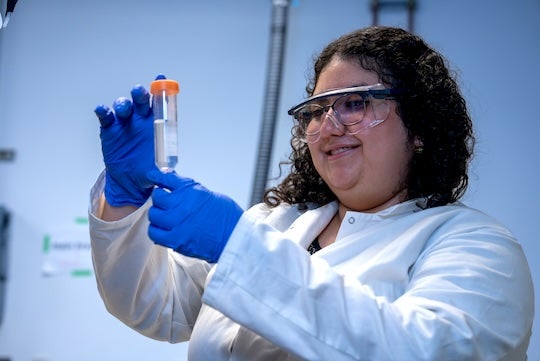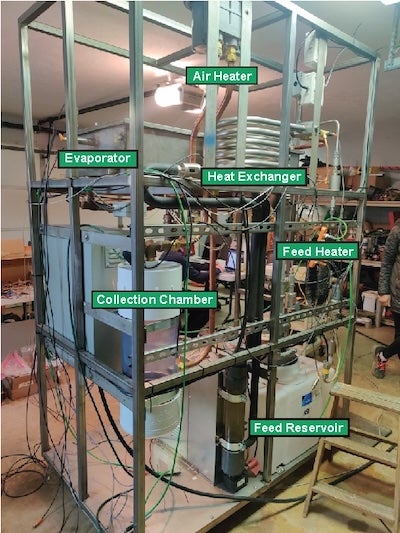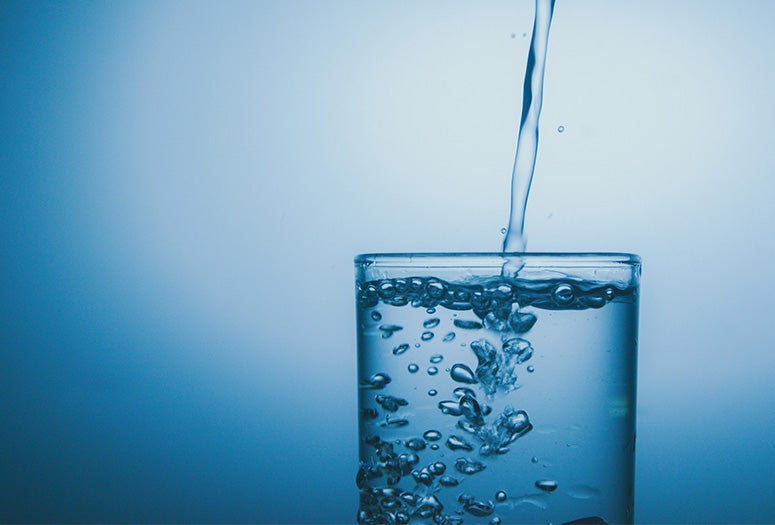Fresh drinking water is a vital yet limited resource that will only grow scarcer over the next few years, according to the World Resources Institute. Desalination, the process of removing salt from water, is an established method used to increase the fresh water supply, especially in coastal regions. However, current desalination systems are dependent on large-scale centralized infrastructure and filtration membranes prone to fouling and degradation.
A team of Rice University engineers has developed a system that could transform desalination practices, making the process more adaptable, resilient and cheaper. The new system, described in a study published in Nature Water, is designed to be powered by sunlight and uses a creative approach to heat recovery for extended water production ⎯ with and without sunshine. In contrast to conventional systems, the setup is made from nondegradable materials and can handle high-salinity brines.
“Access to clean fresh water is a particularly challenging problem in off-grid communities,” said William Schmid, a doctoral student in electrical and computer engineering at Rice and National Science Foundation Fellow researching methods to increase the efficiency of light-driven desalination. “We wanted to focus on decentralized, modular desalination systems.”

Thermal desalination entails cycles of evaporation and condensation: As water evaporates, solids such as salts and other impurities are left behind; meanwhile, water vapor cools and condenses into fresh water. Evaporation uses up energy to overcome the intermolecular forces that characterize water in the liquid phase, and condensation releases the energy as vapor turns back into liquid. For thermal desalination systems to be efficient, the energy generated in the transition between liquid and vapor must be recovered and reused.
The new technology, called Solar Thermal Resonant Energy Exchange Desalination or STREED, leverages water flow and airflow using insights from the physics of resonant systems such as pendulums and electrical circuits. In resonant systems, energy naturally oscillates between different forms in a repeating cycle, doing so most efficiently at specific “resonant” frequencies.
Instead of energy alternating between potential and kinetic as in a pendulum or bouncing back and forth between a magnetic and an electric field as in a tuned electrical circuit, STREED is all about conserving the energy exchanged between two counter-flowing fluids: a stream of heated saline water and a flow of air. When tuned correctly, heat oscillates between these two streams in a resonant pattern, efficiently storing and transferring thermal energy even as the sun retreats behind clouds or the horizon. Because of this self-contained “resonant energy transfer,” STREED does not require external energy storage technologies, which add to the cost and maintenance burden of the overall system.
“Our key innovation is using insights from electrical engineering and the physics of oscillators to inform the adjustment of the system’s internal flow rates to match the sun’s shifting power throughout the day,” Schmid said. “This light-dependent flow control hasn’t been done before.”

Aleida Machorro-Ortiz, a graduate student in the Applied Physics Graduate Program at Rice and a first author on the study alongside Schmid, said the system operates “robustly and with minimal maintenance around the clock.”
The system was tested in San Marcos, Texas, producing up to 0.75 liters of drinking water per hour in its prototype form. The team also performed a range of simulations using solar intensity profiles from different locations across the U.S. ⎯ from cloudy Portland, Oregon, to sunny Albuquerque, New Mexico. Overall, STREED water-recovery efficiency outperformed systems using static flow rates by 77% for a representative week.
“This supports the idea that while the system benefits from sunny locations in terms of total freshwater output, achieving high energy-to-water efficiency is not dependent on high solar intensity,” Machorro-Ortiz said.
Most desalination plants use reverse osmosis (RO) technology, which cannot treat high-salinity water effectively due to membrane-based limitations. RO fresh water recovery rates from seawater are 35-50% with the rest typically discarded as hypersaline water. Meanwhile, STREED is able to handle high salinities without a significant decrease in water production or quality.
STREED also replaces the delicate membranes found in many desalination systems with something far simpler: air. In place of a more traditional two-liquid channel design separated by a membrane, the team uses a single heated channel of polluted or salty water and an adjacent channel of air that carries away water vapor. The vapor then condenses in a water-air heat exchanger, leaving contaminants behind.

“The system is more robust because we don’t have any membranes to foul or break,” said Alessandro Alabastri, assistant professor of electrical and computer engineering at Rice and a corresponding author on the study. “We were intentional in using durable, low-maintenance materials to make the system easily scalable and accessible.”
Naomi Halas, University Professor, the Stanley C. Moore Professor of Electrical and Computer Engineering and a professor of chemistry, physics and astronomy and bioengineering at Rice, is also corresponding author on the study alongside Alabastri. Additional authors are Qian Ye, a Rice graduate student; Pratiksha Dongare, former Rice faculty and senior physicist at SLB; and Peter Nordlander, Rice’s Wiess Chair in Physics and Astronomy and professor of electrical and computer engineering and materials science and nanoengineering.
The research was supported by the National Science Foundation (1842494), Mexico’s National Council of Science and Technology (2021-000014-01EXTF-00140), the Robert A. Welch Foundation (C-1220 and C-1222) and the Department of Energy’s Solar Desalination Prize. The content herein is solely the responsibility of the authors and does not necessarily represent the official views of the funding organizations and institutions.
- Peer-reviewed paper:
-
Resonant energy transfer for membrane-free, off-grid solar thermal humidification-dehumidification desalination | Nature Water | DOI: 10.1038/s44221-025-00438-3
Authors: William Schmid, Aleida Machorro-Ortiz, Qian Ye, Peter Nordlander, Pratiksha Dongare, Naomi Halas and Alessandro Alabastri
https://www.nature.com/articles/s44221-025-00438-3

